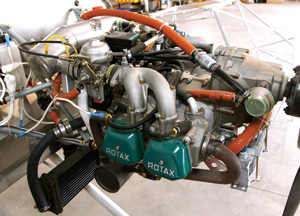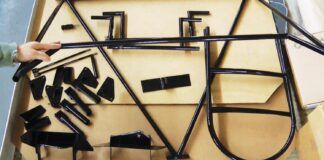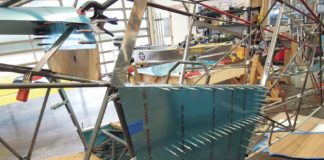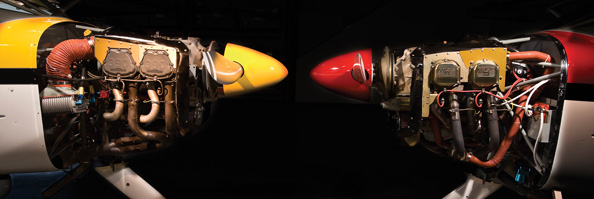
Spring is in the air-metaphorically, at least. (As we put the finishing touches on this buyers guide, were getting the first big set of winter storms.) So it must be time to talk engines. As in years past, we have collected important data on the engines you, the homebuilder, are likely to use. Unlike the previous installments, though, we’ve decided to split up traditional aircraft engines from those derived from automotive powerplants; the old familiars will appear this month, and the alternatives (along with prop-speed reduction units [PSRUs]) will arrive in the April issue. No fooling!
We realize this is sometimes a difficult distinction, but heres our thinking. Engines or engine packages for homebuilders that start as auto engines-no matter how remotely-will be listed in the alternative column. Well apologize in advance for those engine builders who, for example, use a Volkswagen-like architecture but no actual VW parts. Were not trying to diminish your efforts, but the fact is these engines started life as Ferdinand Porsches design for a peoples car.
Engines designed from the start as aircraft engines are listed here, and well not brook arguments from semanticists claiming that Lycomings are also generator engines and that Continentals power tanks. Moving on, then…
In the News
Market forces have influenced your choices. If you tried to buy an engine in 2009, you know that Superiors demise as part of the Thielert group collapse and other supply-side shortcomings have left engine builders scrambling for certain parts. Were told that camshafts were in short supply after Crane Cams went out of business last year; flat (non-roller) lifters for Lycomings are still hard to get; shops were crimped by shortages of various cylinder assemblies throughout the year. (For more on the future of Lycomings and Superiors efforts, see Around the Patch: Combustion pressure and the future of aero engines.)
There’s new management at both Continental and Lycoming as we ease into 2010. Its impossible to predict whether Continental will pay more attention to the Experimental market through direct efforts, or where Lycomings Thunderbolt series is going long term. The general sense is that all businesses in our beloved field have simply pulled back, reduced expectations and battened down to weather the economic storm. Cant say we blame them.
Still, Looking Ahead
On the controls front, Lycoming continues to fly its IE2 electronic-controls (or FADEC) on the Lancair Evolution prototype, and has indicated it wants more of the Experimental pie. Continental, which was delivering its Aerosance-designed FADEC through Mattituck, has pulled the first-generation design from the market but says it is hard at work on a Version 2.0; we anticipate that it will show up first in a certified form and then trickle over (we refuse to say trickle down) to homebuilts.
Aftermarket ignition and injection systems continue to grow in popularity for traditional aircraft engines, but thats literally another story for another day. Until then, lets look at engines.
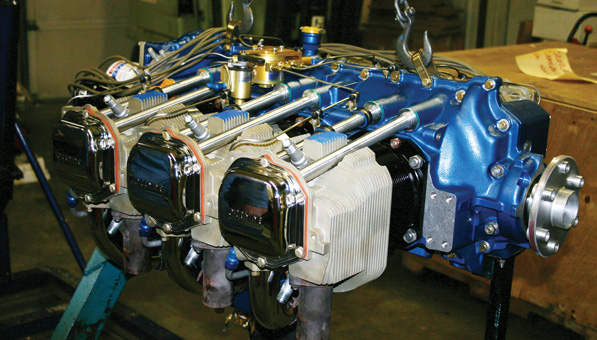
Barretts IO-540.
Lycoming and Lycoming-style Engines
In general terms, these four- and six-cylinder opposed engines define the center of gravity in the homebuilders world. So many aircraft designs were penned with these engines in mind for the simple reason that they were widely available used or as rebuildable cores during the rapid growth of Experimental aviation. Eventually, the market matured and professional shops were able to build custom versions, which pushed momentum in the direction of aftermarket suppliers-Engine Components, Inc. and Superior Air Parts were the big ones-to build complete, new engines based on the venerable Lycoming architecture. We call these clone engines because the vast majority of their parts are interchangeable with factory-built, even certified, Lycoming engines.
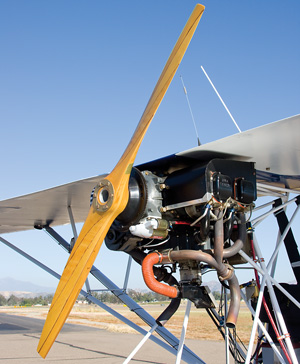
The 150-hp Lycoming O-320-E2D.
The Lycoming-style engines listed here share some important characteristics. All are air-cooled, opposed-cylinder designs featuring pushrod valve actuation and direct propeller drive. Typically, you will find two different cylinder assemblies on these engines, though sometimes the bare engine nomenclature leaves you wondering. The so-called parallel-valve cylinder assemblies began life in the lower-powered engines; they have their valve stems parallel, which creates a mainly circular combustion chamber. These cylinder assemblies, owing to their roots as lower-powered designs, have fewer fins and innately less cooling capacity than the angle-valve designs. They are heavier, with many more fins, because they were designed for higher-power designs. Their valve stems are set at an angle, giving a slightly spherical combustion chamber thats ever so slightly superior. (However, crafty engine modifiers have been able to gain back some of that advantage.) Confusingly, one IO-360 might be an angle-valve engine, while another IO-360 might be the parallel-valve version-and its not just the cylinders. The high-horsepower IO-360, for example, has a different crankcase, crankshaft and other details; its not a matter of cylinder choice alone. Your one solid clue is that the 200-horsepower version of the IO-360 is likely to be the angle-valve model, while the parallel-valve iteration is almost always rated at 180 hp. And yet, some modifiers have been able to get 200 hp (or nearly so) from the parallel-valve design with higher compression ratios and other changes. In six-cylinder form, the 260-hp IO-540 is likely to be a parallel-valve design, while the 300-hp IO-540 will have angle-valve cylinders. Phew.
Something else: Lycoming originally built this series of engines for original-equipment manufacturers (Cessna, Piper, etc.), and they often had specific installation requests. So there are myriad variations on a theme, with carburetors or fuel injection fitted to the bottom of the oil sump (called vertical induction), to the front or rear (horizontal induction), with different accessory-case layouts, provisions for prop governors and a hollow crankshaft nose to accommodate a constant-speed prop, plus a bunch of others. Its important to understand which specific engine subspecies your airframe-kit builder had in mind, because the layout of the engine mount, configuration of the baffling and a handful of other items will depend on it. Fortunately, the aftermarket has whittled Lycomings hundreds of choices down to a few, so you’ll be deciding on things like induction layout, magneto choice (or electronic ignition), fixed-pitch or constant-speed prop, and so on-the big things, in other words. Finally, understand that these listings aren’t the end-all of rated power, equipped weight, or physical engine size; we have asked for dry weights and most vendors responded, but there will be variations based on accessory choice. Best to ask about critical specs before buying.
| Model | Base Price | Base Power | Induction | Dry Weight | Cylinder Design | Prop | Number Delivered | Availability | Notes |
|---|---|---|---|---|---|---|---|---|---|
| Aero Sport Power, www.aerosportpower.com | |||||||||
| O/IO-320, 160 hp | $22,000 | 160 @ 2700 | Carb or injection | 200 | Parallel | FP/CS | 220 | 6 weeks | |
| O/IO-360, 180 hp | $22,200 | 180 @ 2700 | Carb or injection | 290 | Parallel | FP/CS | 750 | 6 weeks | |
| O/IO-375, 195 hp | $24,000 | 195 @ 2700 | Carb or injection | 290 | Parallel | FP/CS | 60+ | 6 weeks | Long-stroke parallel-valve IO-360. |
| IO-360-AIB6, 200 hp | $36,500 | 200 @ 2700 | Injection | 330 | Angle | FP/CS | 75 | 10 weeks | |
| IO-390, 210 hp | $36,500 | 210 @ 2700 | Injection | 330 | Parallel | CS | 45 | 8 weeks | |
| O/IO-540, 260 hp | $41,400 | 260 @ 2700 | Carb or injection | 404 | Parallel | CS | 150+ | 8 weeks | |
| Barrett Precision Engines, Inc., www.bpaengines.com | |||||||||
| O/IO 320-X, 150-160 hp | $22,500 | 150 @ 2700 | Carb or injection | 285 | Parallel | FP/CS | 200+ | 12 weeks | 160 hp version available. |
| O/IO 360-X, 180-195 hp | $23,000 | 180 @ 2700 | Carb or injection | 285 | Parallel | FP/CS | 200 | 12 weeks | With higher compression, 195 hp possible. |
| IO/AEIO 390-X, 210-215 hp | $33,350 | 210 @ 2700 | Injection | 308 | Angle | CS | 50+ | 12-14 weeks | |
| O/IO 360-X, 200-215 hp | $37,085 | 200 @ 2700 | Carb or injection | 280 | Parallel | FP/CS | 200+ | 12 weeks | With higher compression, 215 hp possible. |
| O/IO-540-X, 260-298 hp | $41,975 | 260 @ 2700 | Carb or injection | 397 | Parallel | CS | 200+ | 12-14 weeks | Higher output with cold-air induction and raised compression ratios. |
| IO-540-X, 300-325 hp | $57,272 | 300 @ 2700 | Injection | 380 | Angle | CS | 200+ | 12-14 weeks | Higher output with cold-air induction and raised compression ratios. |
| Eagle Engines, www.americanpropeller.com, 360/691-6123 | |||||||||
| Xtreem 320, 150-160 hp | $21,062 | 150 @ 2700 | Carb or injection | 285 | Parallel | FP/CS | 12 | 4-6 weeks | Higher compression available for 160 hp. |
| EXP Titan Series 320, 150-160 hp | $21,062 | 150 @ 2700 | Carb or injection | 270 | Parallel | FP/CS | 25 | 3-4 weeks | |
| EXP Titan 340 S Stroker, 185 hp | 195 @ 2700 | Carb or injection | 285 | Parallel | FP/CS | 1 | 3-4 weeks | Call for pricing. | |
| Xtreem 360, 180 hp | $22,462 | 180 @ 2700 | Carb or injection | 288 | Parallel | FP/CS | 250+ | 4-6 weeks | |
| EXP Titan Series 360, 180 hp | $25,854 | 180 @ 2700 | Carb or injection | Parallel | FP/CS | 25 | 3-4 weeks | ||
| Xtreem 390, 210+ hp | 210 @ 2700 | Injection | 308 | Angle | CS | 3 | 4-8 weeks | Call for pricing. | |
| Engine Components, Inc., www.eci.aero. Note: Prices are set by individual shops. | |||||||||
| TITAN Kit Engine OX-320, 154-167 hp | 154 @ 2700 | Carb | Parallel | FP/CS | Std 7.0:1 compression. 8.5:1 makes 164 hp, 9.0:1 makes 167 hp. | ||||
| TITAN Kit Engine IOX-320, 156-169 hp | 156 @ 2700 | Injection | Parallel | FP/CS | 2 weeks | Std 7.0:1 compression. 8.5:1 makes 166 hp, 9.0:1 makes 169 hp | |||
| TITAN Kit Engine OX-340S, 177 hp | 177 @ 2700 | Carb | Parallel | FP/CS | 2 weeks | Carbureted, long-stroke engine. | |||
| TITAN Kit Engine IOX-340S, 185 hp | 185 @ 2700 | Injection | Parallel | FP/CS | 2 weeks | Injected version of the 340 stroker. | |||
| TITAN Kit Engine OX-360, 175-189 hp | 175 @ 2700 | Carb | Parallel | FP/CS | 2 weeks | Std 7.0:1 compression. 8.5:1 makes 185 hp, 9.0:1 makes 189 hp | |||
| TITAN Kit Engine IOX-360, 178-191 hp | 178 @ 2700 | Injection | Parallel | FP/CS | 2 weeks | Std 7.0:1 compression. 8.5:1 makes 188 hp, 9.0:1 makes 191 hp | |||
| Lycoming Engines, www.lycoming.com. Note: Listed price is Thunderbolt engine as published on company web site. Prices for OE engines may vary. | |||||||||
| Lycoming 235 Series, 115-125 hp | $20,700 | Carb | 243 | Parallel | FP | ||||
| Lycoming 320 Series, 140-160 hp | $22,350 | Carb or injection | 268 | Parallel | FP/CS | ||||
| Lycoming 360 Series, 180-200 hp | $23,250 | Carb or injection | 278 | Parallel | FP/CS | ||||
| Lycoming 390 Series, 210 hp | $32,650 | Injection | 308 | Angle | CS | ||||
| Lycoming 540 Series, 235-350 hp | $37,000 | 235 @ 2575 | Carb or injection | 356 | Parallel | FP/CS | |||
| Lycoming 580 Series, 315-320 Hp | $57,600 | 315 @ 2700 | Injection | 444 | Angle | CS | |||
| Teledyne Mattituck Services, www.mattituck.com | |||||||||
| TMX O/IO-320, 150-166 hp | $22,450 | 150 @ 27000 | Carb or injection | 273 | Parallel | FP/CS | 8-10 weeks | ||
| TMX O/IO-360, 180-186 hp | $24,950 | 180 @ 2700 | Carb or injection | 285 | Parallel | FP/CS | 100+ | 12-16 weeks | |
| TMX IO-360, 200 hp | $37,160 | 200 @ 2700 | Injection | 315 | Angle | CS | 2 | 12-16 weeks | |
| TMX IO-390, 210 hp | $36,850 | 210 @ 2700 | Injection | 308 | Angle | CS | 53 | 6-8 weeks | |
| TMX IO-540, 250-260 hp | $41,349 | 250 @ 2700 | Injection | 397 | Parallel | FP/CS | 38 | 12-16 weeks | |
| TMX IO-540, 300 hp | $51,500 | 300 @ 2700 | Injection | 469 | Angle | CS | 1 | 12-16 weeks | |
Continental Engines
In the heyday of aircraft engine and certified-aircraft development, a natural pecking order emerged, with Lycoming owning the lower-horsepower end of the market and Continental becoming the dominant maker in the big-engine, high-power category. In the Experimental world, this follows suit, though not as slavishly. And the balance is changing, with Continental recently developing the O-200 into a lightweight, Light Sport Aircraft-friendly powerplant. Moreover, Lycomings aggressive push into advanced technologies-including electronic fuel injection-has given new life to the big-bore IO-540 series. Still, if you’re building a big Lancair or Velocity, you’re encouraged to go with a gold-painted engine.
Unlike Lycoming, which has moved into the Experimental market through its Thunderbolt program as well as its kit-engine business, Continental maintains an OE-only mentality. You get your Continental through your kit manufacturer or from an aftermarket shop. In our research, parts support into the aftermarket isn’t nearly as good with a Continental design as it is for a Lycoming, and with Continentals new management structure, its hard to know if thats going to change.
As with the Lycomings, all Continental engines listed here are air-cooled, opposed-cylinder designs with low-mounted single cams and pushrod valve actuation. Two versions of big-bore cylinders are used: One has the intake ports on the bottom, next to the exhaust ports, and the other is loosely termed a crossflow design because the intakes are on the top. The crossflow heads are normally teamed with a tuned induction system featuring equal-length intake runners. In the 1980s, Continental changed its popular IO-520 to an IO-550 by lengthening the stroke; in essence, 520 and 550 cylinders are the same. Continentals smaller engine, the IO-360, has never really made inroads into Experimental aircraft for a couple of good reasons: Its more complex (read: heavier) and more expensive than a four-cylinder Lycoming of the same power. The new O-200 Lightweight is, however, a good choice for airframes needing around 100 hp and for owners who don’t want a Rotax.
| Model | Price Range | Base Power | Induc-tion | Dry Weight | Prop | Number Delivered | Avail-ability | Notes |
|---|---|---|---|---|---|---|---|---|
| Barrett Precision Engines, www.bpaengines.com | ||||||||
| IO/TSIO 550-X, 310-350 hp | $43,000 – $77,000 | 310 @ 2700 | ||||||
| 350 turbo | Injection | 442 | CS | 200 | High end of price range is turbocharged TSIO-550. Available as 0 SMOH only. | |||
| IO-550/TSIO-500 Lancair Reno Engine, 310-350 hp | 310 @ 2700 | |||||||
| 350 turbo | Injection | 470 | CS | 13 | Available only through Lancair. | |||
| Teledyne Continental Engines, www.genuinecontinental.aero. Note: Continental does not sell direct to consumers. Contact your kit manufacturer for prices. | ||||||||
| O-200-Lightweight, 100 hp | $21,499 | 100 @ 2750 | Carb | 199 | FP | Lightweight version of venerable O-200. | ||
| IO-360-ES, 210 hp | 210 @ 2800 | Inject. | 370 | CS | Top-down, tuned-induction version of Continentals small six. | |||
| IO-550-G, 280 hp | 280 @ 2500 | 467 | CS | Tuned-induction engine with reduced max rpm for low-noise applications. | ||||
| TSIO-550-E, 350 hp | 310 @ 2600 | 565 | CS | Turbocharged and intercooled. | ||||
| Teledyne Mattituck Services, www.mattituck.com | ||||||||
| TMX O-200, 100 hp | $20,455 | 100 @ 2700 | Carb | 215 | FP | 57 | 6-8 weeks | |
| TMX IO-240, 125 hp | $21,435 | 125 @ 2800 | 240 | FP | 35 | 6-8 weeks | ||

Its round, raucous and Russian-must be the Vedeneyev M-14P.
Radials
Who can resist the thumpa-thumpa idle of a round engine? Certainly not us. Currently, for homebuilders, the choices are relatively few, but they’re good ones. The Russian-built Vedeneyev M-14P is a nine-cylinder air-cooled radial of around 350 hp. At the other end of the scale are the Rotec radials, delightful, jewel-like round powerplants rated at up to 150 hp.
| Model | Base Price | Base Power | Induction | Dry Weight | Type | Prop | Prop Drive | Number Delivered | Availability | Notes |
|---|---|---|---|---|---|---|---|---|---|---|
| Barrett Precision Engines, Inc., www.bpaengines.com | ||||||||||
| M-14P, 365-400 hp | $24,000 | 365 @ 2950 | Carb or injection | 417 | 4-stroke | CS | Gear reduction | 8 | 14 weeks | Up to 400 hp with high-performance overhaul. |
| Compact Radial Engines, www.compactradialengines.com | ||||||||||
| SD-570, 28 hp | $4,480 | 28 @ 4200 | Carb | 41 | 2-stroke | FP | Direct | Special order only. | ||
| SC-430, 24 hp | $9,230 | 24 @ 4200 | Carb | 37 | 2-stroke | FP | Direct | Special order only. | ||
| HCI Aviation, www.hciaviation.com | ||||||||||
| R-180, 75 hp | $150 | 75 @ 2150 | Carb | 122 | 4-stroke | FP | Direct | 2 weeks | Engine plans only. Kits no longer offered. | |
| R-220, 125 hp | $220 | 125 @ 2150 | Carb | 138 | 4-stroke | FP | Direct | 2 weeks | Engine plans only. Kits no longer offered. | |
| M-14P, Incorporated, www.m-14p.com | ||||||||||
| M-14P, 360 hp | $22,500 | 350 @ 2950 | Carb | 471 | 4-stroke | CS | Gear reduction | 70+ | Special order only. | |
| Rotec Engineering Pty. Ltd., www.rotecradialengines.com | ||||||||||
| R2800 Radial, 110 hp | $15,925 | 110 @ 3700 | Carb | 220 | 4-stroke | FP | Gear reduction | 500+ | ||
| R3600 Radial, 150 hp | $21,010 | 150 @ 3600 | Carb | 275 | 4-stroke | FP | Gear reduction | |||
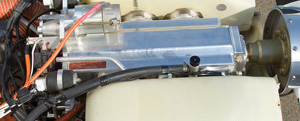
Jabirus line of aircraft engines are all air-cooled, direct-drive designs (above). They range from a four-cylinder, 85-hp engine up through an eight-cylinder, 180-hp powerplant.
Small Piston Engines
Experimental-class aircraft have the benefit of using a wide range of engines. For convenience, we’ve created a sub-class of these engines for your consideration. Included are the types we view as designed from the ground up as aircraft engines. Yes, you will find that, for example, the early Rotax 2-stroke engines share design concepts and parts with, say, snowmobile engines, and, if you look really close, the Jabirus have some auto-engine components in them. However, in all cases, the primary design point and development strategies have centered on the aircraft application. This is a good thing, as aircraft demands are quite different from those presented by cars, motorcycles, snowmobiles, watercraft and leaf blowers.
| Model | Base Price | Base Power | Config. (1) | No of cyls | Type | Cool- ing | Induct- ion | Dry Wght | Prop Drive | No. Delivered | Avail-ability | Notes |
|---|---|---|---|---|---|---|---|---|---|---|---|---|
| Air Parts Sales Unlimited, LLC, www.shop.apsu-hks.com | ||||||||||||
| HKS 700E, 60 hp | $9,371 | 60 @ 6200 | HO | 2 | 4-stroke | Air | Carb | 120 | Gear red. | 1400 | 2 weeks | |
| HKS 700T, 75 hp | 75 @ 5300 | HO | 2 | 4-stroke | Air | Inject. | 126 | Gear red. | Price TBD; unit still in develop-ment. | |||
| Compact Radial Engines, www.compactradialengines.com | ||||||||||||
| MZ-100, 18 hp | $2,120 | 18 @ 9700 | Inline | 1 | 2-stroke | Air | Carb | 65 | Gear red. | 240 | 4 weeks | |
| MZ-34, MZ-35, 27 hp | $2,970 | 27 @ 6250 | Inline | 1 | 2-stroke | Air | Carb | 37 | Gear red. | 240 | 4 weeks | |
| MZ-201, 45 hp | $4,440 | 45 @ 4700 | Inline | 2 | 2-stroke | Air | Carb | 65 | Belt red. | 470 | 2 weeks | |
| MZ-202, 60 hp | $5,660 | 60 @ 5800 | Inline | 2 | 2-stroke | Air | Carb | 85 | 1080 | 2 weeks | ||
| MZ-301, 85 hp | $9,230 | 85 @ 5800 | Inline | 3 | 2-stroke | Air | Carb | 85 | Gear red. | 50 | 2 weeks | |
| Hirth Engines, www.recpower.com | ||||||||||||
| F-33, 28 hp | $2,600 | 28 @ 6000 | Inline | 1 | 2-stroke | Air | Carb | 35 | Belt red. | 1500+ | Immed. | Fan or free-air cooling. |
| 2702, 40 hp | $3,476 | 40 @ 5000 | Inline | 2 | 2-stroke | Air | Carb | 76 | Gear red. | 1000+ | Immed. | Fan or free-air cooling. |
| 3202, 55 hp | $4,423 | 55 @ 5500 | Inline | 2 | 2-stroke | Air | Carb or Inject. | 76 | Belt red. | 500+ | Immed. | Fuel Inject. option $1430. Fan or free-air cooling. Belt red. also available. |
| F-23, 50 hp | $4,423 | 50 @ 6150 | HO | 2 | 2-stroke | Air | Carb | 84 | Belt red. | 1000+ | Immed. | Belt red. drive $880 extra. |
| 3203, 65 hp | $5,143 | 65 @ 6300 | Inline | 2 | 2-stroke | Air | Carb or Inject. | 76 | Belt or gear red. | 1000+ | Immed. | Fuel Inject. option $1430. Fan or free-air cooling. Belt red. also available. |
| 3503, 70 hp | $5,988 | 70 @ 6500 | Inline | 2 | 2-stroke | Liquid | Carb or Inject. | 79 | Gear red. | 350 | Immed. | |
| F-30S, 100 hp | $8,586 | 100 @ 6300 | HO | 4 | 2-stroke | Air | Carb or Inject. | 105 | Gear red. | 5000 | Immed. | Fan or free-air cooling. Fuel Inject. optional. |
| Jabiru Engines, www.usjabiru.com | ||||||||||||
| 2200A, 85 hp | $13,500 | 85 @ 3300 | HO | 4 | 4-stroke | Air | Carb | 140 | Direct | 3500 | Immed. | |
| 3300A, 120 hp | $17,500 | 120 @ 3300 | HO | 6 | 4-stroke | Air | Carb | 180 | Direct | 2700 | Immed. | |
| 5100A, 180 hp | $26,000 | 180 @ 2800 | HO | 8 | 4-stroke | Air | Carb | 275 | Direct | 80 | 8 weeks | |
| Rotax Engines, www.rotax-aircraft-engines.com. Note: Rotax does not provide retail prices. Contact your local Rotax Service Center (see box above) for more information. | ||||||||||||
| Rotax 447 UL, 40 hp | 40 @ 6500 | Inline | 2 | 2-stroke | Air | Carb | 57 | Gear red. | Immed. | |||
| Rotax 503 UL, 50 hp | 50 @ 6500 | Inline | 2 | 2-stroke | Air | Carb | 69 | Gear red. | Immed. | |||
| Rotax 582 UL, 65 hp | 65 @ 6500 | Inline | 2 | 2-stroke | Liquid | Carb | 64 | Gear red. | Immed. | |||
| Rotax 912 UL, 81 hp | 81 @ 5800 | HO | 4 | 4-stroke | Liquid | Carb | 121 | Gear red. | Immed. | |||
| Rotax 912 ULS, 100 hp | 100 @ 5800 | HO | 4 | 4-stroke | Liquid | Carb | 125 | Gear red. | Immed. | |||
| Rotax 914 ULS, 115 hp | 115 @ 5800 | HO | 4 | 4-stroke | Liquid | Carb | 144 | Gear red. | Immed. | |||
| Note 1: Configuration, HO = horizontally opposed. | ||||||||||||
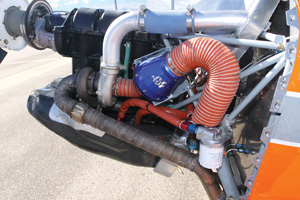
The Wilksch WAM-120 diesel remains alive and well; the one shown below is living in Kurt Goodfellows Vans RV-9.
Diesels
Ah, yes…the ever-elusive compression-ignition reciprocating aircraft engine. As in the past, were listing details on the DeltaHawk engine. Call us hopeful. Looking back at the 2005 Engine Directory, as we called it then, three DH designs are listed, one as having 12 examples in the field. In updating our records, the term production to begin in 2009 has been replaced with production to begin in 2010. We are not aware of any customer aircraft currently flying with the DeltaHawk. If you need a reasonable barometer of any designs success, you cant go far wrong by counting the number of flying examples with happy (or at least mildly contented) owners.
This description is not intended as a slam against DeltaHawk-those of us with an eye for engines see some real intrinsic beauty in the design-but it should prove a cautionary tale. Developing a new engine, of any kind, is a daunting task that is best done in concert with a well-funded airframe manufacturer. In todays economic climate, few airframe companies (kit or otherwise) are willing to take the risk.
The other diesel available for homebuilts, the Wilksch, has taken a similarly long and careful development path, but is shipping in small quantities and is flying in other than factory prototypes. (In fact, we had a chance to fly an RV-9 equipped with the three-cylinder Wilksch, and will report on that in an upcoming issue.)
How about Thielert engines? Were told there’s no corporate interest in homebuilts. Or the SMA opposed-cylinder, 4-stroke-cycle diesel? Last we heard, the company was still looking for an airframe manufacturer to help develop a firewall-forward package. None that were aware of have come forward in these shaky economic times.
Stop in next month for a look at alternative engines for homebuilts.
| Model | Base Price | Power | Configu-ration | No of cyls | Type | Cool- ing | Induct- ion | Dry Weight | Prop Drive | Prop | Number Delivered | Avail-ability |
|---|---|---|---|---|---|---|---|---|---|---|---|---|
| Wilksch Airmotive, www. wilksch.com | ||||||||||||
| WAM-120, 120 hp | 15,000 | 120 @ 2750 | Inline | 3 | 2-stroke diesel | Liquid | Mech. injection | 220 | Direct | Constant speed | 40+ | Varies |
| DeltaHawk, www.deltahawkengines.com | ||||||||||||
| DH 160, 160 hp | $62,500 | 160 @ 2700 | Upright or inverted Vee | 4 | 2-stroke diesel | Liquid | Mech. injection | 330 | Direct | Fixed pitch or constant speed | ||
| DH 180, 180 hp | $62,500 | 180 @ 2700 | Upright or inverted Vee | 4 | 2-stroke diesel | Liquid | Mech. injection | 330 | Direct | Fixed pitch or constant speed | ||
| DH 200, 200 hp | $62,500 | 200 @ 2700 | Upright or inverted Vee | 4 | 2-stroke diesel | Liquid | Mech. injection | 330 | Direct | Fixed pitch or constant speed | ||

